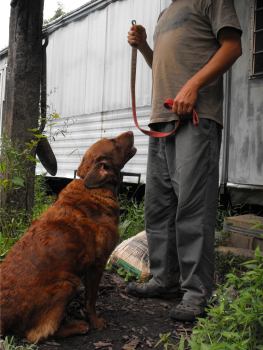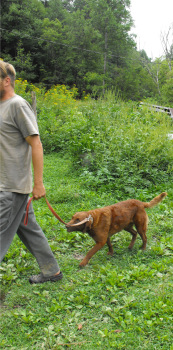
How to walk your dog
 We based our extremely simple dog training
regimen on Cesar Millan's book Cesar's
Way: The Natural, Everyday Guide to Understanding and Correcting Common
Dog Problems.
The entire book can be broken down into a couple of paragraphs ---
Cesar argues that dogs are naturally pack animals with one leader and a
lot of followers. Rather than training your dog lots of fancy
tricks to get her to do what you want, you only need to make her
understand that you are the pack leader. Then be sure that your
pet also gets plenty of exercise and you'll have a well-behaved dog.
We based our extremely simple dog training
regimen on Cesar Millan's book Cesar's
Way: The Natural, Everyday Guide to Understanding and Correcting Common
Dog Problems.
The entire book can be broken down into a couple of paragraphs ---
Cesar argues that dogs are naturally pack animals with one leader and a
lot of followers. Rather than training your dog lots of fancy
tricks to get her to do what you want, you only need to make her
understand that you are the pack leader. Then be sure that your
pet also gets plenty of exercise and you'll have a well-behaved dog.
Cesar solves both the pack leader and exercise problem with one simple
answer --- walk your dog. Sounds simple, but most people
(including us before we read the book) do it all wrong. When you
walk your dog correctly, she should be walking at your side or behind
you --- you're in charge of determining where you're going and how fast
you're going. The dog shouldn't be stopping to sniff and pee
unless you decide to stop and let the dog sniff and pee. The goal
is to get the dog used to following your lead and looking to you for
directions.
 Cesar recommends that your dog should have an
hour of exercise a
day. We are a bit more lax than that --- I generally walk Lucy in
the morning for about 20 minutes and Mark generally walks her in the
evening for about 20 minutes. If she were cooped up indoors all
day, though, rather than able to run around on the farm, we'd probably
have to walk her longer.
Cesar recommends that your dog should have an
hour of exercise a
day. We are a bit more lax than that --- I generally walk Lucy in
the morning for about 20 minutes and Mark generally walks her in the
evening for about 20 minutes. If she were cooped up indoors all
day, though, rather than able to run around on the farm, we'd probably
have to walk her longer.
Food is also an integral element in the walk. Rather than giving
your dog meals as if it were his or her due, you should start feeding
your dog after the walk. When I come back from walking Lucy in
the morning, I take off her leash and tell her to sit and stay at the
door. She waits for a couple of minutes as I go in the house and
get her breakfast, and she stays seated until I've put the food in
front
of her. This is yet one more way to make sure that Lucy knows
that I'm in charge of the food and that she has to be calm and obedient
in order to get any.
The walk is an important ongoing piece of training for your dog.
When one of us isn't feeling well and we just toss her a bowl of food
without a walk, Lucy is far more likely to misbehave the next
day. When we're out of town for a few days and she doesn't have
any walks, she's a bit wild when we return. I like to think that
walking Lucy is like keeping an eye on our relationship. Strong
human relationships are based on constant negotiations, and your
relationship
with your dog is no different.
| This post is part of our Training a Farm Dog lunchtime series.
Read all of the entries: |
Want more in-depth information? Browse through our books.
Or explore more posts by date or by subject.
About us: Anna Hess and Mark Hamilton spent over a decade living self-sufficiently in the mountains of Virginia before moving north to start over from scratch in the foothills of Ohio. They've experimented with permaculture, no-till gardening, trailersteading, home-based microbusinesses and much more, writing about their adventures in both blogs and books.
Want to be notified when new comments are posted on this page? Click on the RSS button after you add a comment to subscribe to the comment feed, or simply check the box beside "email replies to me" while writing your comment.
